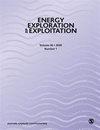Geochemical characteristics of Jurassic high-sodium coal in Tatuo Coal Mine, Qinghai Province, China
IF 1.6
4区 工程技术
Q4 ENERGY & FUELS
引用次数: 0
Abstract
Sodium in the coals of West China has received persistent attention due to its high contents and severe pollutions’ problems during coal utilization. A total of seven drill samples of the Jurassic coals from Tatuo coalfield, Qinghai Province, were collected and analysed using optical microscopy, scanning electron microscopy in conjunction with energy-dispersive X-ray spectrometry, X-ray powder diffraction, inductively coupled plasma mass spectrometry and X-ray fluorescence spectrometry. The results indicate that the Tatuo coal is of lower-high ash, medium volatile matter and ultra-low sulphur bituminous coal. Tatuo coal contains much more Na2O (> 2%), and belongs to high-sodium coal. The maceral index and element ratios of Sr/Cu, Fe/Mn and Sr/Ba showed that Tatuo coal was formed in a terrestrial peat swamp environment. The minerals in Tatuo coal, including clay minerals and halite, quartz, gypsum and rutile, are mainly concentrated in the bottom and top parts of the coal seam. Combined with scanning electron microscopy in conjunction with energy-dispersive X-ray spectrometry and optical microscope characteristics, the sodium could be carried into the peat/coal after the peat formation by basin fluids. The East Kunlun orogenic belt may be the main source of these minerals.青海塔托煤矿侏罗系高钠煤地球化学特征
我国西部煤中的钠含量高,在煤炭利用过程中存在严重的污染问题,一直受到人们的关注。采用光学显微镜、扫描电子显微镜、能量色散X射线光谱法、X射线粉末衍射法、电感耦合等离子体质谱法和X射线荧光光谱法对青海省塔托煤田侏罗系煤的7个钻孔样品进行了分析。结果表明,塔托煤为低高灰、中挥发分、超低硫烟煤。塔托煤含Na2O较多(>2%),属于高钠煤。岩石显微组分指标和Sr/Cu、Fe/Mn、Sr/Ba元素比值表明,塔托煤形成于陆地泥炭沼泽环境中。塔托煤中的矿物主要集中在煤层的底部和顶部,包括粘土矿物和石盐、石英、石膏和金红石。结合扫描电子显微镜、能量色散X射线光谱法和光学显微镜特性,钠可以在泥炭形成后通过盆地流体携带到泥炭/煤中。东昆仑造山带可能是这些矿物的主要来源。
本文章由计算机程序翻译,如有差异,请以英文原文为准。
求助全文
约1分钟内获得全文
求助全文
来源期刊

Energy Exploration & Exploitation
工程技术-能源与燃料
CiteScore
5.40
自引率
3.70%
发文量
78
审稿时长
3.9 months
期刊介绍:
Energy Exploration & Exploitation is a peer-reviewed, open access journal that provides up-to-date, informative reviews and original articles on important issues in the exploration, exploitation, use and economics of the world’s energy resources.
 求助内容:
求助内容: 应助结果提醒方式:
应助结果提醒方式:


